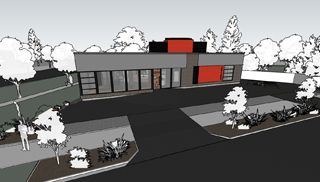|
Subscribe / Renew |
|
|
Contact Us |
|
| ► Subscribe to our Free Weekly Newsletter | |
| home | Welcome, sign in or click here to subscribe. | login |
Architecture & Engineering
| |
 |
October 25, 2012
Architects get creative to meet green expectations
The Fearey Group

Chaitin
|
For the last decade, green design has transitioned from superlative to status quo, becoming a fundamental element of architectural design across all building sectors — commercial and civic to higher education and aerospace manufacturing. As building owners look to designs that continually improve efficiency, add sense of place, reduce environmental impacts and add to the bottom line, architects are charged with creating green projects that can go from concept to construction while delivering the intended results.
With the rapid introduction of new and ever-adapting sustainable design systems, how can architects, engineers and contractors ensure these projects are fully realized? While the industry has learned from failed green designs (buildings that sacrifice indoor air quality in the name of energy efficiency, rain gardens that inadvertently become mini-flood zones), Seattle is home to a plethora of successful green projects where challenges were assessed, addressed and resulted in meaningful, measureable and sustainable outcomes.
The Supply Laundry Building in South Lake Union is an example of one of the most challenging green efforts an architect can undertake: the restoration of a historic structure and adaptation into a high performance LEED-CS platinum building. More than 100 years old, Supply Laundry was built in the heyday of the area’s commercial laundry industry. Vulcan Real Estate is preserving the building for speculative office use, alongside a 278-unit apartment development called StackHouse, which is under construction.
The architect, Runberg Architecture Group, was faced with the challenge of transforming a historically significant building into a high-performance adaptive reuse that will preserve the building’s historic integrity while dramatically improving energy efficiency and reducing the project’s environmental footprint. To accomplish this, the team worked with The Preservation Green Lab and the city of Seattle to pilot an outcome-based energy code compliance path for permitting.
The architect worked closely with the collective project team to use features such as storm windows to insulate inefficient original single-pane windows, generous natural ventilation and daylight, and air source heat pump systems for space heating and cooling to reduce the energy signature of the building.
Green pizzeria
Another project involved designing Pagliacci Pizza’s newest location in Seattle’s Madison Valley neighborhood. Here the architect and client set out to create Seattle’s only stand-alone LEED-certified pizzeria on a former brownfield (the site had been home to both a gas station and dry cleaner).
Matt Galvin, president and co-owner of Pagliacci, has been an advocate of sustainable business practices, and initially looked into the possibility of adapting heat exchangers to the pizza ovens to heat the building’s air and water.
However, the reality of site cleanup meant looking to create budget efficiencies elsewhere and giving up on the heat exchangers. So architect Richard Floisand and his team at Floisand Studio looked to the other resource-intensive uses associated with a restaurant — primarily water and electricity — and adapted their design to incorporate highly efficient fixtures and lighting, while designing with abundant natural light to help create a space that was warm and inviting but far less energy and water intensive than would be typical.
While both of these projects represent significantly different challenges associated with green building design, they each required the architects to engage in creative problem solving to deliver outcomes that met their clients’ expectations, leading to the creation of truly sustainable outcomes.
In the case of the Supply Laundry Building, the architects worked with the Preservation Green Lab to help the city of Seattle embrace the possibilities of combining historic preservation with energy conservation to create what will be one of the most innovative and efficient adaptive reuse project’s in the region.
And in the case of Pagliacci Pizza’s newest location, the architect looked to the owner to compromise on some of the design features to address cleanup and site stabilization, and to ensure that even without heat exchangers, the building would be one of the greenest restaurant spaces in the region.
Josh Chaitin is senior vice president with The Fearey Group, a Seattle-based public relations agency serving numerous clients in the built environment throughout the region. Chaitin leads the Fearey Group’s real estate and sustainability practice areas, and has more than 20 years of experience working on environmental issues and sustainable development.
Other Stories:
- TAF building is a calm respite among the trees
- Survey: Baylis Architects
- Survey: Lance Mueller and Associates
- Survey: NAC Architecture
- Survey: Cary Kopczynski & Co.
- Survey: Swenson Say Faget
- Survey: Weber Thompson
- Survey: MulvannyG2 Architecture
- Economic downturn doesn’t slow sustainability
- Seattle’s climate puts a chill into data centers
- Sustainable living doesn’t have to be expensive
- Early flood warning gets a boost from technology
- Retailers mix it up; architects adjust
- How strong is your building’s public safety radio signal?
- Consulting engineers change the playbook as prime consultants
- Survey: Rice Fergus Miller Architecture & Planning



